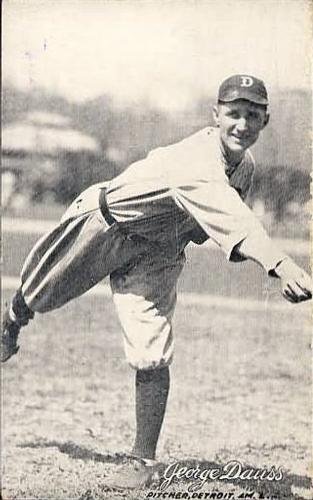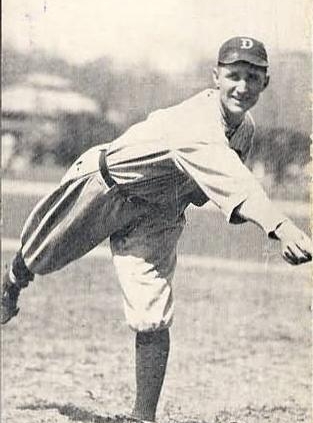June 17, 1925: Tigers bat around twice in the 6th, Hooks Dauss earns 200th career win
 Blowout games take on many different forms. There are blowouts when one team consistently bludgeons the other into submission by scoring early and consistently adding on to the score over the course of the game. Two in the first, three in the second, and so on. And, then there are blowouts that are the result of a big inning — an overwhelming torrent of runs that leaves the opponent in dismay. The Wednesday afternoon contest between New York Yankees and the Detroit Tigers was one such game.
Blowout games take on many different forms. There are blowouts when one team consistently bludgeons the other into submission by scoring early and consistently adding on to the score over the course of the game. Two in the first, three in the second, and so on. And, then there are blowouts that are the result of a big inning — an overwhelming torrent of runs that leaves the opponent in dismay. The Wednesday afternoon contest between New York Yankees and the Detroit Tigers was one such game.
The Yankees entered the game in sixth place with a 23-31 record, a half-game ahead of the seventh-place Tigers. The Yankees were led by 30-year-old Babe Ruth who was in the process of playing his way back into shape after missing the first six weeks of the season because of an intestinal problem that became known as “The Bellyache Heard ’Round the World.”1 The Tigers were led by 38-year-old Ty Cobb, the club’s star center fielder who was in his fifth year as player-manager.
The pitching matchup pitted a pair of veteran right-handed hurlers who were nearing the tail end of their careers. Diminutive George “Hooks” Dauss, nicknamed for his signature curveball used to compensate for an average fastball, toed the rubber for the Tigers.2 Dauss was 4-5 and entered the game stuck on 199 career victories. Bob Shawkey, a four-time 20-game winner with 180 career wins to his credit, took the mound for the Yankees. Shawkey, who kept a mental book on hitters and their tendencies, entered the game with an uncharacteristic 1-6 record.3
The game started at 3:30 P.M. with a temperature of 71 degrees under overcast skies. The first two innings suggested the game might have shaped up as a pitchers’ duel. Shawkey navigated his way around a pair of first-inning hits and retired the Tigers in order in the second, while Dauss countered with two scoreless frames of his own.
The Tigers got to Shawkey in the top of the third. Catcher Johnny Bassler led off the inning with a single to right. After Dauss struck out, Fred Haney singled to center and Bassler advanced to second. Shawkey appeared as though he might wiggle off the hook when he retired second baseman Frank O’Rourke on a popout to third. However, left fielder Al Wingo singled to center and both Bassler and Haney scored when center fielder Earle Combs committed an error that allowed Wingo to advance to second. Cobb singled to right to drive in Wingo and after Harry Heilmann reached on an error, first baseman Lu Blue plated the inning’s fourth run with a single to left-center.
The score stayed at 4-0 until the top of the sixth. Right-hander Alex Ferguson, who had come on in relief of Shawkey in the top of the fourth, started the record-setting inning that Detroit Free Press sportswriter Harry Bullion described as an “orgy that was frightful in the extreme and one in which the winners could take no pride.”4 Heilmann started things off with a single, Blue doubled, and Jackie Tavener drew a walk to quickly load the bases for the Tigers. Bassler then “bounded to Ferguson,” whose errant throw found the grandstand and allowed both Heilmann and Blue to score.5 The light-hitting Dauss added insult to injury and ended Ferguson’s afternoon when he tripled to center, driving in Tavener and Bassler.
Rookie right-hander Walter Beall followed Ferguson and issued consecutive walks to Haney, O’Rourke, and Wingo, forcing Dauss across the plate and increasing the Tigers’ lead to 9-0. With the bases still loaded, Yankees manager Miller Huggins summoned another rookie right-hander, Hank Johnson, to face Cobb. Cobb deposited Johnson’s second offering deep into the right-field bleachers for a grand slam as the Tigers runners formed “in battalion front with the fife-and-drum corps going ahead.”6 The Bengals’ lead was now 13-0.
Heilmann followed with a triple, his second hit of the inning, but the Tigers’ right fielder pulled up lame after cruising into third and was replaced by Heinie Manush.7 Rattled by the rude welcome he received from the Tigers’ two future Hall of Famers, Johnson walked Blue and Tavener to reload the bases. Bassler reached on an error for the second time in the inning when Yankees second baseman Aaron Ward fumbled his grounder, allowing Manush and Blue to score the Tigers’ 14th and 15th runs. Dauss walked and again the sacks were filled with Tigers.
At this point, three Yankee hurlers had failed to record a single out in the sixth inning as the Tigers sent 14 men to the plate and scored 11 runs on five hits, plus seven walks and a pair of errors. Desperate to stop the bleeding, Huggins went to the bullpen for the third time in the inning and brought in Sad Sam Jones, who had tossed a complete-game victory against the Tigers just three days earlier.
Jones and the Yankees recorded the first out of the inning when Haney hit a sacrifice fly to Ruth in right, scoring Tavener. O’Rourke followed with a single to left that scored Bassler with the frame’s final run. The inning came to a merciful end when Wingo and Cobb both flied to Ruth, who recorded all three putouts in the epic inning. The 13-run rampage lasted 49 minutes and saw the Tigers bat around twice.8 When the dust had settled, the Yankees rallying cry had turned to “only 17 to tie and 18 to win!”9
Dauss, who hadn’t thrown a pitch in nearly an hour, returned to the mound in the bottom of the sixth and retired the side in order. Ruth, Combs, and Irish Meusel were all retired on fly outs. In sharp contrast to the top of the sixth, the Tigers went down in order in the top of the seventh.
The Yankees finally got on the scoreboard when 22-year-old Lou Gehrig led off the bottom of the seventh with his fourth home run of the year, a shot that landed deep in the right-field bleachers. The score remained 17-1 until the top of the ninth inning. Les Burke, who had run for O’Rourke during the Tigers’ marathon sixth inning, led off with a single. Wingo followed with a two-run, inside-the-park home run to center field that extended the Tigers’ advantage to 19-1. Cobb followed with a single, but was thrown out by Wally Schang attempting to steal second. Manush singled for the fourth hit of the inning before Johnny Neun, who replaced Blue at first base in the bottom of the eighth, flied out to center. Tavener ended the Tigers ninth by grounding out to Gehrig at first.
Dauss retired the first two Yankees in the bottom of the ninth before Gehrig sent a triple to center. Dauss then retired Ward on a groundout to third to wrap up a beautifully pitched complete-game four-hitter that was lost in the clamor surrounding the blowout. The victory was the 200th of Dauss’s career. Nearly three months later, he earned his 210th win and eclipsed George Mullin as the winningest pitcher in Tigers history.10
Detroit baseball history is tied to the big inning. While newspaper accounts of the game suggested the 11 runs the Tigers scored before a batter was retired may have been a record, the 13-run sixth inning was not a record for most runs scored in an inning. The outburst was five runs shy of the major-league-record 18 runs the National League’s Chicago White Stockings scored in the seventh inning against the Detroit Wolverines on September 6, 1883.11 Similarly, on June 18, 1953, the Tigers were victimized by the biggest inning in American League history when the Boston Red Sox scored 17 in the seventh inning at Fenway Park.12
Sources
In addition to the sources cited in the Notes, the author also consulted Baseball-Reference.com and Retrosheet.org
Notes
1 Allan Wood, “Babe Ruth,” SABR BioProject. https://sabr.org/bioproj/person/9dcdd01c.
2 Bob O’Leary, “Hooks Dauss,” SABR BioProject. https://sabr.org/bioproj/person/414508cb.
3 Stephen Rice, “Bob Shawkey,” SABR BioProject. https://sabr.org/bioproj/person/69fabfcf.
4 Harry Bullion, “Athletics’ Record of Season Equaled,” Detroit Free Press, June 18, 1925: 14-15.
5 Bullion.
6 James Harrison, “19 to 1 Landslide Smothers Yankees,” New York Times, June 18, 1925: 17.
7 “Bengals Move to Sixth Place by Victory,” Detroit Free Press, June 18, 1925: 14.
8 Harrison.
9 Harrison.
10 Dauss earned 223 victories with the Tigers and as of 2019 remained the club’s all-time winningest pitcher.
11 The game was part of a four-game sweep in which the White Stockings outscored the Wolverines by a combined score of 65-16.
12 The Tigers’ 23-3 loss that day came on the heels of a 17-1 blowout loss to the Red Sox the day earlier.
Additional Stats
Detroit Tigers 19
New York Yankees 1
Yankee Stadium
New York, NY
Box Score + PBP:
Corrections? Additions?
If you can help us improve this game story, contact us.


